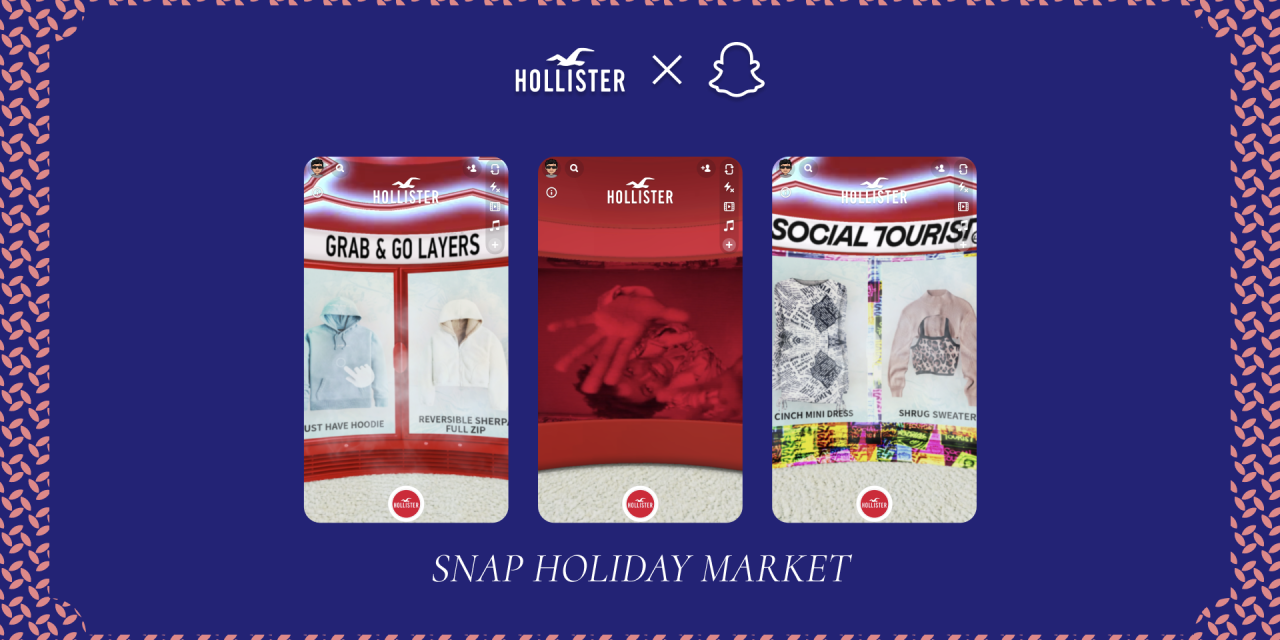Hollister is partnering with Snap for an augmented reality holiday marketplace

This Black Friday, Hollister is launching a shoppable augmented reality holiday marketplace on Snapchat.
Hollister joins Coca-Cola, Prime Video, Under Armour, Verizon and Walmart in offering virtual Snap storefronts in time for the holidays. The marketplace goes live on Friday and run through the end of the year. Hollister will sell a selection of comfort-focused apparel and gifts from two of its three brands — Hollister and Social Tourist — via a shop meant to look like a modern convenience store.
Snap — formerly Snapchat — claims that its AR lenses — a suite of 3D effects, objects, characters and transformations that users can put on Snapchat photos and videos — accumulate 6 billion plays a day, and Hollister hopes to court the platform’s active teen user base. While Snap may be successfully recruiting brands to try out AR commerce, many brands still have to find ways to draw consumers to the technology. In apparel, specifically, the use case for AR is still early, as many brands still haven’t created a way for customers to say, try on clothing using AR.
Commerce via AR is increasingly a priority for Snap and active advertisers grew both quarter-over-quarter and year-over-year. The platform, however, underperformed when it came to revenue expectations — it cited recent iOS 14 privacy policy concerns as one of the reasons it missed those targets. Despite focusing more closely on commerce integrations, Snap’s executives did not share specifics on in-app transactions during its most recent earnings.
Hollister was founded in 2000 under the Abercrombie and Fitch parent company as a surf-inspired brand for teens. Hollister’s 506 brick-and-mortar stores are primarily located in malls across the U.S., Asia, South America and Europe.
Over the years, it’s tried to stay relevant with its younger customer base. In 2008, Hollister released intimates sub-brand Gilly Hicks and relaunched the brand in 2019 via Hollister store-within-stores to play to trending interest from young consumers in popup concepts. This year, Hollister partnered with Gen Z social media influencers Charli and Dixie D’Amelio for its second sub-brand, Social Tourist.
Hollister’s senior director of brand marketing strategy, Jacee Scoular, described the Snap partnership as Hollister’s first foray into “commerce-led AR.”
Ad position: web_incontent_pos1
“As we think about new ways to connect with our consumer — staying close to where they’re spending their time and how their shopping behaviors are evolving — we were excited to lean into the AR innovation,” said Scoular. “This aligns really nicely back to how [teens] are thinking about social as the new storefront and as the new way to discover and buy products.”
Hollister has partnered with Snap for numerous partnerships over the past few years, including sponsoring the platform’s spring break live takeover in 2016 and releasing a Bitmoji fashion line in 2018. “Our consumer spends a lot of time on Snapchat,” said Scoular.
This latest AR experience will highlight a selection of loungewear, party apparel and gifts from Hollister and Social Tourist in a storefront meant to mimic the look of a “modern edgy” convenience store, explained Scoular. Products, for example, will displayed in virtual glass cases that look like convenience store fridges to highlight the “grab and go” nature of the retailer’s apparel basics.
The holiday market, featuring all of the participating brands’ storefronts, will be promoted on the Snap Lens carousel, Snap’s Lens Explorer for you page and each participating brand’s Snapchat profile. If a consumer wants to purchase a product from any of the brands’ storefronts, Snap will help them check out in app.
The opportunities and challenges of AR
Snap has recently been doubling down on its augmented reality investments, rolling out an AR asset creation studio, an AR agency and marketplace to connect AR creators with brands.
Complex used the technology to simulate IRL-product-drops online during its ComplexCon event earlier this month and, in the platform’s upcoming holiday market, other brands will be taking similarly creative approaches. Coke has also used Snap’s technology to recreate a mall-Santa meet and greet with a Coke-branded spin. Meanwhile, Verizon is using it as a treasure hunt for consumers to find limited-time discounts on phone, gaming and music tech.
Ad position: web_incontent_pos2
“With Snapchat now seeing over 6 billion AR Lens plays every day from our community, it’s incredibly exciting to see brands lean into our AR platform at this important time of year,” said Luke Kallis, vp of U.S. advertiser solutions at Snap over email.
Snap has reported that 306 million people use Snapchat daily and 500 million people use Snapchat monthly. The company says that users open the app 30 times a day, on average. Moreover, year-over-year daily active user growth has growth over 20% for four quarters straight. However, experts interviewed by Modern Retail are skeptical about AR’s ability to drive sales.
Andrew Lispman, e-commerce analyst at eMarketer, previously told Modern Retail that while there has been “some hyping [around AR],” many use cases are “edge cases” for only certain types of product categories.
For apparel in particular, AR can prove challenging. While brands like Ulta have used augmented reality try-ons or by Wayfair for at-home furniture visualizations, providing sizing guidance or accurately showing what clothing could look like on is more complicated. Indeed, Hollister’s Snap partnership won’t have virtual try-on, and is instead focused on product-discovery and mimicking an in-store browsing experience at home.
“We’re at the beginning of the [AR] journey for our brands,” said Scoular. “There’s a ton of stuff in try-on, avatar [and] virtual reality spaces that we’re currently exploring, but I would say we don’t quite have it ready… When [our consumers] start moving more and more into this space, that’s something we definitely have our eye on.”

